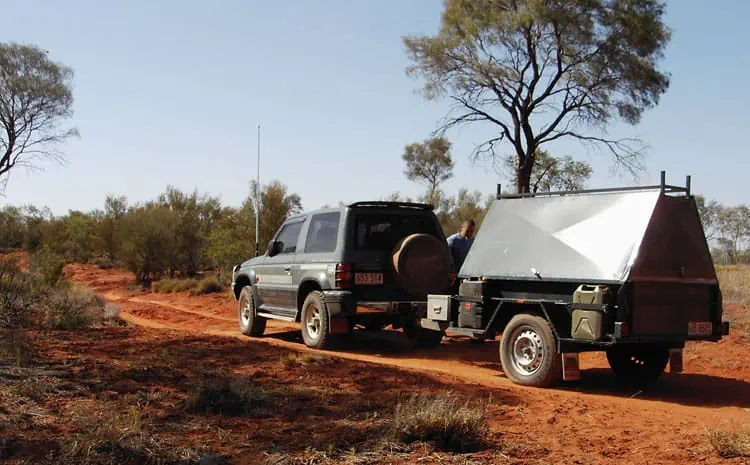Camping Trailer
Although caravans are a comfortable way to tour, you can go anywhere with a good camping trailer(I am not referring to a ‘camper trailer’ here). Initially, I thought about buying a manufactured off-road, u-beaut, ready-to-go camping trailer. However, anything decent and suitable for the trips I wanted to do would cost an arm and a leg. As a result, I looked around and purchased a solid trailer built in South Australia.
 Old Andado Track
Old Andado Track
The first trip I did with the trailer was along the Old Andado Track on the edge of the Simpson Desert. My father towed an older-style pop-up caravan, and we spent a week or so exploring a beautiful part of Australia. At this stage, the trailer didn’t have a canopy, just the bare trailer, and I wanted to see how the trailer handled it before doing more.
The trailer tracked well and was fantastic on the deeply corrugated Andado Track. At the end of this trip, I decided that the trailer was worth fitting into an actual camping trailer. The short-wheeled based Pajero you see in the pictures has a 2.4-litre turbo-charged diesel, not underpowered, but overall, it is on the small side. For this reason, I opted to build a canopy that wasn’t square, more like a trade canopy. This shape means the camping trailer has less wind resistance. It follows the vehicle’s wheel tracks and provides plenty of room inside. There is even space to put my small generator!
Camping Trailer The Fit Out
Once I fitted the canopy, it was onto the fun of fitting it out and making it into an actual camping trailer. Firstly, and forward of the axle, I fitted a 60-litre water tank (cased inside a 3mm galvanised skin). The system used a 12v pressure pump inside the trailer and a tap outlet at the rear of the canopy. Nothing like having running water… although you need to educate people to use it sparingly. For contingency, there is another 40L of water in two external jerry cans. It provides 100 litres, enough for a couple of weeks if used sensibly.
I then built a roll-out cupboard to hold all foodstuffs, pots n pans, cutlery and any other imaginable item my wife wished to carry. Finally, after months in the shed, I had a full slide-out rear kitchen with a sink and four-burner gas stove. (some would say a kitchen is overkill, and something like a woodgas stove would be far better:).
Boggy Hole
The trip through the Finke Gorge National Park (NT) to Boggy Hole was the first trip with this fit-out. By the way, Finke Gorge National Park trip guidelines suggest trailers should be left behind. Unless you are highly experienced, I mean more than ten years of hard four-wheel driving, you should not take a trailer. The track follows the river (fascinating to watch our progression on the GPS), and in places, it is bottomless fine sand. This means you can become hopelessly bogged unless you know what you are doing.
We undertook the trip in January, and temps were regularly over 40°C. In these temperatures, fine sand is treacherously soft, but correct tyre pressures and the application of good driving skills made the trip an enjoyable experience. Nevertheless, I changed to wider rims and tyres on the camping trailer after the trip. Apart from being interchangeable with the vehicle, the larger footprint meant easier towing in soft sand. One final addition was the Howling Moon rooftop tent.
It is always a pleasure to go bush with a camping trailer. This one formed the support hub for the Uluru National Park riders in the 2004 Finke Desert Race.
Camping Trailer Regretful Sale
The camping trailer had very little use on moving to Canberra, and I sold it. In hindsight, it wasn’t the best decision. Five years later, I found myself back in Western Australia, living in Perth. So I purchased a new solid but small box trailer and built a frame to carry the 12-foot dinghy. The old short-wheel base diesel Pajero above was getting tired. A later model Pajero became the replacement. Unfortunately, it was a petrol and juice guzzler. However, it has tons of room, and great to get down on the beach.




 Old Andado Track
Old Andado Track